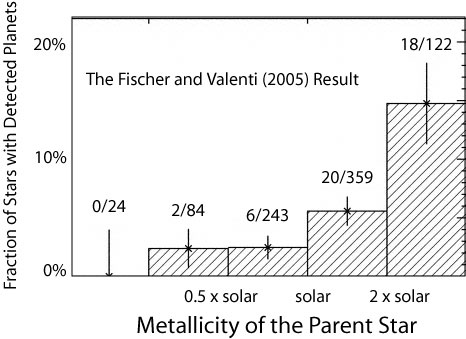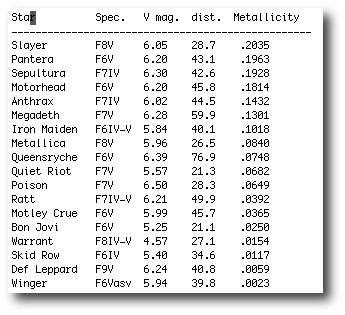
51 Peg is an ordinary star in nearly every respect. It is, however, more metal-rich than the Sun by nearly a factor of two, which gives it a metallicity in excess of all but a few percent of the stars in the local galactic neighborhood.
When Astronomers talk about metallicity, they mean the fraction of a star’s mass that is contained in elements that are heavier than hydrogen and helium. To an astronomer, carbon, nitrogen, krypton, and radon are all “metals”. In the Sun, metals comprise a bit less than 2% of the total mass.
Nearly every parent star in the first wave of extrasolar planets (including 55 Cnc, Tau Boo, and Ups And) came in with considerably higher-than-average metallicity, and the strong connection between high stellar metallicity and the detectable presence of an extrasolar planet was on fairly secure footing by 1997. This connection has been quantified very clearly, and is perhaps the most important and dramatic result that come out of the first decade of investigation of extrasolar planets. The figure from Debra Fischer and Jeff Valenti’s recent paper is fast on its way to iconic status:

The planet-metallicity connection is telling us something important about the planet formation process, namely, that the core-accretion mechanism for forming giant planets is correct. (More on this coming up soon.) It also tells us how to efficiently find more planets. If you want to find planets, look at metal-rich stars.
Purists should definitely argue that by skimming the readily detectable planets from metal-rich stars, one is skewing the statistical properties of overall census of planets, while introducing additional systematic trends into a planetary catalog that is already shot through with biases both subtle and overt. “A targeted quick-look Doppler survey of metal-rich stars is the moral equivalent of eating candy for breakfast!”
I fully agree.
There are, however, scientifically compelling and unassailably selfless arguments for why it’s important to locate as many extrasolar planets as quickly as possible. I think the most important reason is that quick-look radial velocity surveys (such as N2K) are the best way to locate planets that transit bright parent stars. Once identified, objects like HD 149026b yield up a simply incredible amount of information.
But I’ll be straight with everyone. I’ve always wanted to be in on the discovery of new planets.
In 2000, I worked with Debra Fischer on a small-scale survey of metal-rich stars that wound up being the precursor project to N2K. It’s hard to imagine that the year 2000 once seemed like the distant future. At that time, it appeared that in addition to the planet-metallicity correlation, that there was also a planet-stellar mass correlation. The census of short-period planets known in 2000 was noticeably concentrated around stars somewhat more massive than the Sun, that is, early G and late F type stars.
I therefore drew up a list of 20 stars that we could observe using the then-undersubscribed CAT (Coude Auxilliary Telescope) on Mt. Hamilton. The criteria for inclusion were that a candidate star be (1) at least moderately metal-rich, (2) bright, (3) more massive than the Sun, and (4) not known to be on any other radial velocity survey lists. We needed stars brighter than about magnitude 6 because the CAT telescope has a mirror diameter of only one meter.
Rapidly, it became clear that Henry Draper catalog numbers are not a very effective way to mentally keep track of the stars. There was confusion, for example, one night when I asked Debra if I could add “HD Twenty –Six Seven Five” to the evening’s observing list. She thought that I meant “HD 2675 “(which had already set), when I actually had “HD 20675” in mind. We eventually realized that since we needed to keep both the stars and their metallicities straight, the best course of action would be to name the stars after heavy metal bands. At the high-metallicity end, we drew on speed-metal and death-metal outfits (e.g. Slayer, Sepultura), wheras at the lower-metallicity end, we resorted to hair-metal and even glam-metal bands (i.e. Warrant, Skid Row). Here’s our final list of stars in the survey:

(The original twenty star survey was reduced to eighteen after AC-DC turned out to be a spectroscopic binary, and W.A.S.P. turned out to be chromospherically active.)

Is there a correlation between high metallicity and hot Jupiters? The stars that ‘ate’ their planets may have high metallicity while the stars that did not ‘eat’ their planets may have their planets futher out and hence harder to detect.
Will this not skew the sample.
Good point. It will be very interesting to see whether the planet-metallicity correlation continues to hold as strongly for longer-period planets.
When the planet-metallicity connection first became evident, there was a debate as to whether the connection might be the result of parent stars consuming their planetary progeny.
If this hypothesis is correct, then the planet-metallicity connection should be strongest among stars that have shallow convective envelopes. A planet that is consumed by a star will have its metals mixed through only the outer convective layer. Stars that are somewhat more massive than the Sun have very shallow convective envelopes, and so they should show this effect most clearly.
In 1997, Fred Adams and I wrote a paper, “Possible Stellar Metallicity Enhancements from the accretion of Planets” (see http://arxiv.org/abs/astro-ph/9710110) in which we did a statistical analysis of the metallicities of F-type main-sequence stars in the solar neighborhood. We found a marginally significant trend in the direction that one would expect if planets were frequently being accreted during the star-formation process. Over the past several years, however, it has become increasingly clear that most of the planet-metallicity correlation is due to high metallicity of the parent star-forming cloud. Pollution likely occurs, but it likely does not account for the bulk of the planet-metallicity correlation.
My prediction is that the planet-metallicity correlation will be substantially weaker if one considers Neptune-like ice-giant planets in addition to the Jovian-mass planets that are currently known.
Fascinating. Thanks for the reply. Much remains to be learnt.
Rest assured your posts are avidly followed and much appreciated by the ‘lay’ public. Can’t get enough of this noble pursuit.
Pingback: systemic - Motley Crue